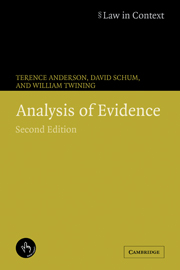Book contents
- Frontmatter
- Contents
- Preface
- Acknowledgments
- Tables of cases and statutes
- Table of legislation and rules
- List of abbreviations
- 1 Evidence and inference: some food for thought
- 2 Fact investigation and the nature of evidence
- 3 Principles of proof
- 4 Methods of analysis
- 5 The chart method
- 6 Outlines, chronologies, and narrative
- 7 Analyzing the decided case: anatomy of a cause célèbre
- 8 Evaluating evidence
- 9 Probabilities, weight, and probative force
- 10 Necessary but dangerous: generalizations and stories in argumentation about facts
- 11 The principles of proof and the law of evidence
- 12 The trial lawyer's standpoint
- Glossary of terms and symbols
- References
- Index
10 - Necessary but dangerous: generalizations and stories in argumentation about facts
Published online by Cambridge University Press: 23 November 2009
- Frontmatter
- Contents
- Preface
- Acknowledgments
- Tables of cases and statutes
- Table of legislation and rules
- List of abbreviations
- 1 Evidence and inference: some food for thought
- 2 Fact investigation and the nature of evidence
- 3 Principles of proof
- 4 Methods of analysis
- 5 The chart method
- 6 Outlines, chronologies, and narrative
- 7 Analyzing the decided case: anatomy of a cause célèbre
- 8 Evaluating evidence
- 9 Probabilities, weight, and probative force
- 10 Necessary but dangerous: generalizations and stories in argumentation about facts
- 11 The principles of proof and the law of evidence
- 12 The trial lawyer's standpoint
- Glossary of terms and symbols
- References
- Index
Summary
Since, then, our inferences from fact to fact depend upon our belief in general rules of connection between fact and fact, generalizations about the way things happen in nature, the work of criticizing inferences resolves itself into that of criticizing generalizations.
(Sidgwick (1884) 9)We have seen that generalizations are almost always necessary as warrants for every step in inferential reasoning, but that they can often be shown to be the weakest points in an argument (Chapter 3). Similarly, we have seen that stories are not just an alternative to analytical approaches such as the chart method, but rather complement them in important ways (Chapter 6). According to some psychologists and practitioners stories are psychologically necessary to decision-making about issues of fact. Yet another strand in the literature suggests that stories are wonderful vehicles for “cheating” in the process of persuasion in legal contexts. In this chapter we look in more detail at the nature of generalizations and stories, their role in fact-determination, some reasons why they can be labeled dangerous, some links between these dangers, and practical techniques for navigating them in litigation.
Generalizations
Reprise and introduction
Generalizations are warrants that serve as the “glue” that links an item of evidence to a particular interim or ultimate probandum by showing that it is relevant (Foundations 81–83, 109). We have previously examined the role of generalizations in arguments about evidence. In Chapter 3 we identified the role that generalizations perform in the application of the principles of logic in constructing and analyzing arguments.
- Type
- Chapter
- Information
- Analysis of Evidence , pp. 262 - 288Publisher: Cambridge University PressPrint publication year: 2005

